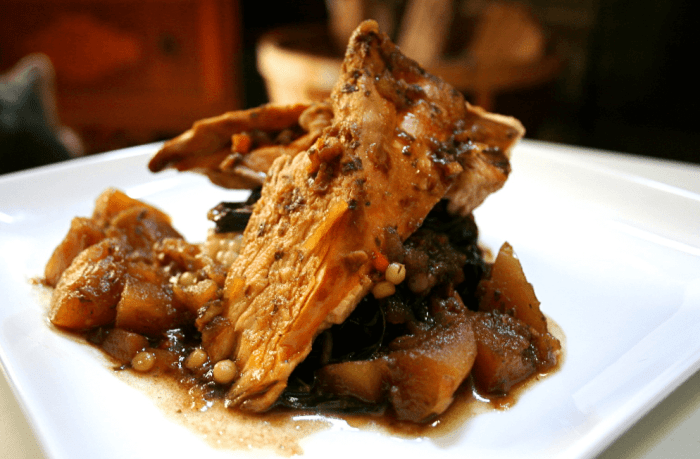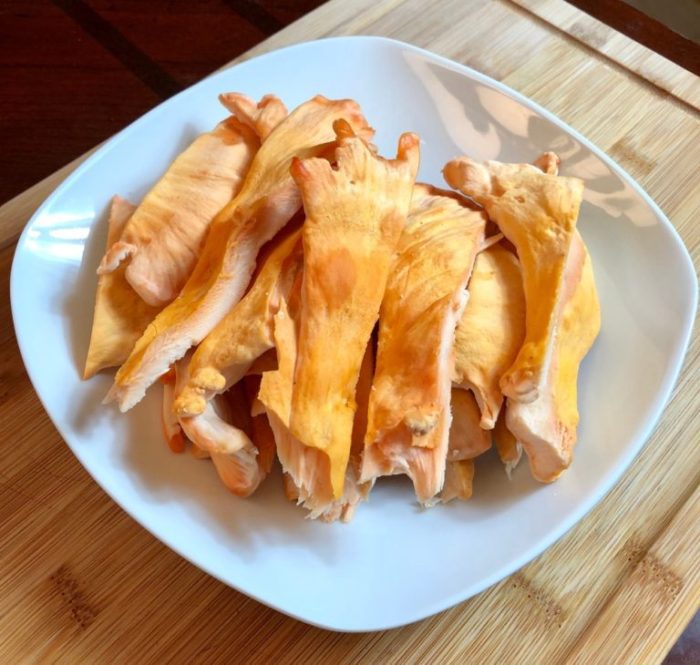
Embark on a culinary adventure with the Chicken of the Woods recipe, a dish that captures the essence of the forest and tantalizes your taste buds. Discover the versatility of this unique mushroom as we delve into its culinary applications, nutritional value, and the art of foraging.
From savory soups to vibrant salads, the Chicken of the Woods shines in a myriad of dishes, adding depth of flavor and a touch of the wild to every bite.
Chicken of the Woods Identification
Chicken of the Woods (Laetiporus sulphureus) is a distinctive and edible mushroom that is commonly found growing on oak trees. It is known for its bright orange or yellow coloration, shelf-like shape, and meaty texture.
If you’re looking for a unique and flavorful meal, consider trying the chicken of the woods recipe . This edible mushroom is known for its meaty texture and umami flavor, making it a great substitute for chicken in various dishes.
To identify Chicken of the Woods, look for the following characteristics:
- Color:Bright orange or yellow, sometimes with a reddish tint.
- Shape:Shelf-like or bracket-shaped, with a wavy or lobed margin.
- Size:Can range from a few inches to over a foot in width.
- Texture:Firm and meaty, with a slightly spongy feel.
- Habitat:Typically grows on dead or dying oak trees, often at the base of the trunk or on fallen logs.
It is important to distinguish Chicken of the Woods from similar-looking mushrooms, such as the False Chicken of the Woods (Hypholoma capnoides). The False Chicken of the Woods has a duller orange color, a more fibrous texture, and does not grow on oak trees.
| Feature | Chicken of the Woods | False Chicken of the Woods |
|---|---|---|
| Color | Bright orange or yellow | Duller orange |
| Shape | Shelf-like or bracket-shaped | Bell-shaped or convex |
| Texture | Firm and meaty | Fibrous and tough |
| Habitat | Oak trees | Various trees, including oak |
Culinary Applications

Chicken of the Woods is a versatile culinary mushroom that can be used in a wide variety of dishes. Its unique flavor and texture make it a great addition to soups, stews, stir-fries, and salads.
Before cooking Chicken of the Woods, it is important to clean it thoroughly. Remove any dirt or debris from the mushrooms and then cut them into bite-sized pieces.
For a tasty and unique culinary experience, look no further than the chicken of the woods recipe . This edible mushroom is known for its chicken-like texture and flavor, making it a perfect substitute for meat in many dishes. Whether you’re grilling, sautéing, or baking, this versatile ingredient adds a delicious and healthy touch to any meal.
In Soups and Stews
Chicken of the Woods adds a rich, earthy flavor to soups and stews. It can be used in place of meat or as an addition to meat-based soups. When adding Chicken of the Woods to soups or stews, be sure to cook it until it is tender but still has a slight bite to it.
In Stir-fries
Chicken of the Woods is a great addition to stir-fries. It can be used in place of or in addition to meat. When using Chicken of the Woods in stir-fries, be sure to cook it until it is browned and slightly crispy.
In Salads
Chicken of the Woods can be used to add a bit of flavor and texture to salads. It can be used in place of or in addition to meat. When using Chicken of the Woods in salads, be sure to cook it until it is tender but still has a slight bite to it.
Nutritional Value and Health Benefits
Chicken of the Woods is not just a delicious mushroom; it’s also packed with nutrients. This vibrant fungus is an excellent source of vitamins, minerals, and antioxidants, making it a valuable addition to any healthy diet.
Nutritional Composition
Chicken of the Woods contains a wide range of nutrients, including:
- Vitamins:Vitamin D, B vitamins, and vitamin C
- Minerals:Potassium, phosphorus, magnesium, and iron
- Antioxidants:Ergothioneine, beta-glucans, and phenolic compounds
Health Benefits
The nutritional composition of Chicken of the Woods contributes to its various health benefits, including:
- Immune System Support:Vitamin D, vitamin C, and beta-glucans support immune function.
- Anti-inflammatory Properties:Ergothioneine and phenolic compounds have anti-inflammatory effects.
- Bone Health:Vitamin D and potassium promote bone health.
- Heart Health:Potassium and fiber support heart health.
Cultivation and Foraging

Cultivating and foraging for Chicken of the Woods requires specific knowledge and responsible practices. This section provides guidelines for successful cultivation and ethical foraging.
Cultivation
Chicken of the Woods can be cultivated on logs or wood chips. Choose hardwood logs, such as oak, maple, or beech, and prepare them by removing bark and cutting them into 12-18 inch lengths. Inoculate the logs with Chicken of the Woods spawn and place them in a shaded, humid environment with temperatures between 55-75°F (13-24°C).
Foraging, Chicken of the woods recipe
Foraging for Chicken of the Woods in the wild requires attention to detail and responsible harvesting. Identify suitable habitats such as oak forests or mixed deciduous woods during late summer to early fall. Look for bright orange shelf-like structures growing on the sides of trees or fallen logs.
Harvest only mature specimens with firm, moist flesh. Use a sharp knife to cut the mushroom at its base, leaving the mycelium intact to promote future growth. Avoid overharvesting and always respect the natural environment.
Preservation and Storage
Chicken of the Woods can be preserved through various methods to extend its shelf life and maintain its flavor. Understanding the best preservation techniques and proper storage guidelines will help you enjoy this delicious mushroom for an extended period.
Drying
Drying is an effective way to preserve Chicken of the Woods and concentrate its flavors. Slice the mushrooms thinly and spread them evenly on a drying rack or dehydrator tray. Dry at a temperature between 110-120°F (43-49°C) for several hours, or until the mushrooms are completely dry and brittle.
Store dried Chicken of the Woods in an airtight container in a cool, dry place for up to a year.
Freezing
Freezing is another convenient method for preserving Chicken of the Woods. Clean and slice the mushrooms and blanch them in boiling water for 2-3 minutes. Drain the mushrooms thoroughly and spread them on a baking sheet lined with parchment paper.
Freeze the mushrooms for at least 2 hours, or until they are solid. Transfer the frozen mushrooms to freezer-safe bags or containers and store them for up to 6 months.
Pickling
Pickling Chicken of the Woods adds a tangy flavor and extends its shelf life. Slice the mushrooms and place them in a jar. Create a pickling solution by combining vinegar, water, sugar, salt, and spices in a saucepan and bring it to a boil.
If you’re looking for a more in-depth guide to preparing chicken of the woods, check out the chicken of the woods recipe from MECCA. This detailed recipe provides step-by-step instructions and helpful tips for cooking this delicious mushroom. From foraging and cleaning to cooking and serving, this guide covers everything you need to know to enjoy this unique culinary delight.
Pour the hot pickling solution over the mushrooms, leaving about 1/2 inch of headspace at the top of the jar. Seal the jar and store it in the refrigerator for at least 2 weeks before consuming. Pickled Chicken of the Woods can be stored in the refrigerator for up to 6 months.
Storage
Fresh Chicken of the Woods should be stored in the refrigerator in a paper bag or a loosely covered container. This allows for proper air circulation and prevents the mushrooms from becoming slimy. Fresh Chicken of the Woods can be stored in the refrigerator for up to 5 days.
Last Recap: Chicken Of The Woods Recipe

Whether you’re a seasoned chef or a curious home cook, the Chicken of the Woods recipe is an invitation to explore the culinary wonders of the natural world. Embrace the flavors of the forest and create dishes that celebrate the bounty of nature.
FAQ Resource
Can Chicken of the Woods be eaten raw?
No, it’s recommended to cook Chicken of the Woods before eating to enhance its flavor and digestibility.
How do I identify Chicken of the Woods?
Look for bright orange, shelf-like clusters with a velvety texture and white pores on the underside.
What are the health benefits of Chicken of the Woods?
It’s a good source of vitamins, minerals, and antioxidants, supporting immune function and reducing inflammation.





